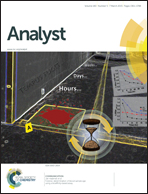Graphene oxide supported gold nanoclusters for the sensitive and selective detection of nitrite ions†
Abstract
The research progress on the selective and sensitive fluorescent detection of nitrite anions has greatly relied on the development of new fluorescent materials. Herein, a novel nanohybrid exhibiting dual emissions in blue and red wavelength ranges is fabricated for the rapid, on-site, and sensitive detection of nitrite anions. Such a nanohybrid system consists of graphene oxide (GO-C6NH2) and gold nanoclusters (HSA-Au NCs), which have been hybridized by electrostatic attraction and hydrogen bonding interaction. The nanohybrid has been completely characterized with respect to its fluorescence properties, photostability, and morphology. It has been found that red fluorescence of gold nanoclusters selectively responds to nitrite, whereas the blue fluorescence of graphene oxide remains constant, resulting in a distinct fluorescence color evolution from red to blue. Therefore, we apply the nanohybrid for the detection of nitrite anions by a fluorescence ratiometric method and estimate a detection limit of 46 nM, lower than the allowable level (∼21 μM) in drinking water set by U.S. Environmental Protection Agency. The method has been further validated by applying it for the determination of nitrite anions in real samples, including tap water, lake water, and cured meat.


 Please wait while we load your content...
Please wait while we load your content...